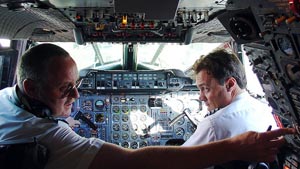Telstra calls for mobiles in-flight

Advances in aviation technology should mean that the hassle of being forced to switch off your phone during a flight should become a thing of the past, according to Telstra's spectrum policy group manager Brian Miller.

(Concord cockpit image by Marko Karppinen, CC2.0)
"The current restraints on the use of phones on aircraft do seem to be overly conservative, and I know Telstra is not aware of any evidence pointing to interference between mobile phones and aircraft electronic systems," Miller told the Australian Communications and Media Authority (ACMA)'s RadComms conference in Sydney this afternoon.
"The avionic systems of today are designed to be very robust and withstand very high electromagnetic field and densities, including those generated by static build-up and direct lightning strikes, which are ... in orders of magnitude, greater than those generated by mobile phones," he said.
"There's a large travelling business population ... that could be a whole lot more productive if this was possible," he added."
In July last year, the ACMA decided to implement licensing arrangements that would allow airlines to deploy technology on the aircraft such as picocells that would allow passengers to connect and make phone calls using their own mobile phones.
It is understood, however, that no Australian airline has yet made the service available to the public.
ACMA's general manager of communications infrastructure, Maureen Cahill, had earlier told the conference that the current regulatory regime for spectrum was very inflexible, and as a result it was not easy to bend the rules to allow mobile phone usage on aircraft.
"In the end, to enable this service to be provided to people [who] want to take it, the proponent [that wanted to offer the service] had to have, in place, third-party authorisation in Australia with three spectrum licensees. Part of its base station concept was apparatus licensed. Parts of handsets and all the rest of it had to be classed licensed," she said.
"We had to make significant changes to regulatory determinations to enable what this day and age you might have through a simple approach."
Miller said that all of this complexity could be avoided if mobile phone customers could just connect straight down to their existing telco network from the aircraft.
"We note that services are being introduced ... which involve phones connecting to a picocell on the aircraft along with a wide-band jamming transmitter," he said. "So why can't those phones also be permitted to connect to a terrestrial network?
"I suggest that a simpler way of doing this 'mobile phones in aircraft' thing might be to simply allow terrestrial access," he said.
Hundreds of megahertz required in the future
Miller also called on the ACMA to get on with the upcoming auction of the 700MHz and 2.5GHz spectrum bands as part of the digital dividend, in order to meet demand for spectrum for mobile broadband services.
"From our perspective, it is essential that the ACMA gets on with the clearance and allocation of the 700MHz band and also the 2.5GHz band to meet the medium term demand for mobile broadband capacity. We can't afford to have any more slippages in the published timetable," he said.
While the ACMA has estimated that Australia will need 300MHz of additional spectrum in order to meet demand by 2020, Miller said that the International Telecommunications Union is looking at an additional 700MHz, while the United States is seeking an additional 500MHz. Miller said that Telstra has yet to determine how much it thought would be required.
"We're still thinking about the quantity of mobile broadband spectrum that is required beyond those two bands. The jury is still out on what is required, but I think it's fair to say that we will need to find hundreds of additional megahertz and primarily below 5GHz as well."